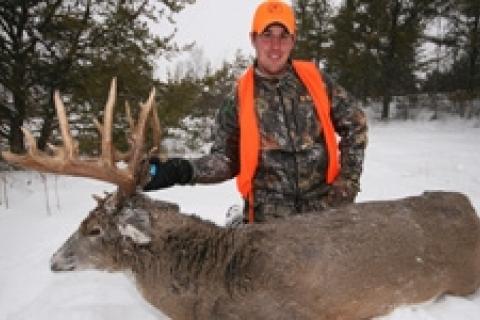
 |
| Trophy-quality bucks can still be found in northwestern Ontario. Photo courtesy of Jeff Gustafson Outdoors |
The area of northwestern Ontario roughly bounded by the towns of Kenora, Ignace and Fort Frances is sometimes called "The Whitetail Triangle." In 2003, this area appeared on the radar screens of serious whitetail hunters when the "Dryden buck" hit the internet — a typical buck net scoring 199 7/8 B&C that was killed illegally. Almost overnight, this thinly-populated area of the Ontario began to see a huge influx of non-resident hunters who took home scores of bucks with heavy, chocolate-colored horns. A decade later, although local experts feel that trophy quality has declined in some areas, there are still opportunities for big bucks.
The area encompasses thousands of square miles, with huge tracts of north woods bush. Although agriculture is prevalent in certain areas, crops are typically hay and other cattle grains, rather than high-protein corn and soybean crops. However, despite harsh winters, and wolf predation, the overall deer population is generally very healthy. Perhaps too healthy, as in some areas it's common to see dozens of deer each evening, mostly does and fawns, including right in the town of Kenora. As northwestern Ontario is less than a day's drive from Michigan, Wisconsin and Minnesota, hunters from the U.S. still flock to the area each year, but because non-residents are only allowed to take bucks, this hunting pressure does little to manage the overall herd in areas that may have too many deer. Generally, however, deer densities are moderate compared with much of the U.S.
While non-resident moose or bear hunters must be accompanied by a guide or registered with a tourist outfitter, there is generally no such requirement to hunt deer; however, your best opportunity to tag a big buck is by hunting with a quality outfitter. There are literally dozens of outfitters in the region, most of whom also offer some hunting for moose, bear, wolf, waterfowl and grouse at various times. Your best odds lay with an outfitter that is serious about deer hunting and scouts extensively, hunts either private land or very remote areas of public land to control hunting pressure and takes only a small number of hunters each year.
There's a huge variation in what is offered by local outfitters, ranging from total do-it-yourself hunts with nothing more than accommodations provided, right up to fully-guided, all-inclusive packages. Most outfitters in the region lean toward semi-guided housekeeping packages. All of them hunt from stands primarily, but some organize small drives as well. As much of this region is big woods, baiting is widely practiced, but even that varies. Some outfitters offer carefully chosen, pre-baited stand sites, while others have little more than a shooting lane cleared in the bush with the hunter required to bring his own treestand or ground blind and bring or purchase bait. It's critical to ask and understand exactly what's included for accommodations, meals, guiding, etc.
Two such outfitters are Jeff Gustafson Outdoors and Indian Point Camp. Contact the Ontario Ministry of Natural Resources for more information on hunting in northwestern Ontario.
Good hunting.
- 5074 views

